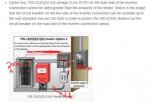Kalyan
Member
- Location
- Kansas City, Mo, USA
I am trying to interconnect a PV system to a feeder at a location other than the opposite end of the feeder from its primary source overcurrent device. As per NEC 705.12(D)(2)(1)(b) i need to protect the feeders on the load side of the inverter output connection by having an overcurrent device on the load side of the inverter connection that is not greater than the ampacity of the feeder. It makes sense but the question i have is do i need to place this overcurrent device on the load side immediately after my inverter output connection or can the feeders run to a load center inside the house where there is an existing OCPD (main breaker of panel) that comes before any load connections? Please take a look at the image below to get a clear idea of my situation here. This link - https://www.jadelearning.com/jadele...2014-nec-705-12d2-pv-interconnections-part-2/ shows an interpretation of this part of the code that supports my situation. Let me know if anyone at the Mike holts forum group agrees. 


